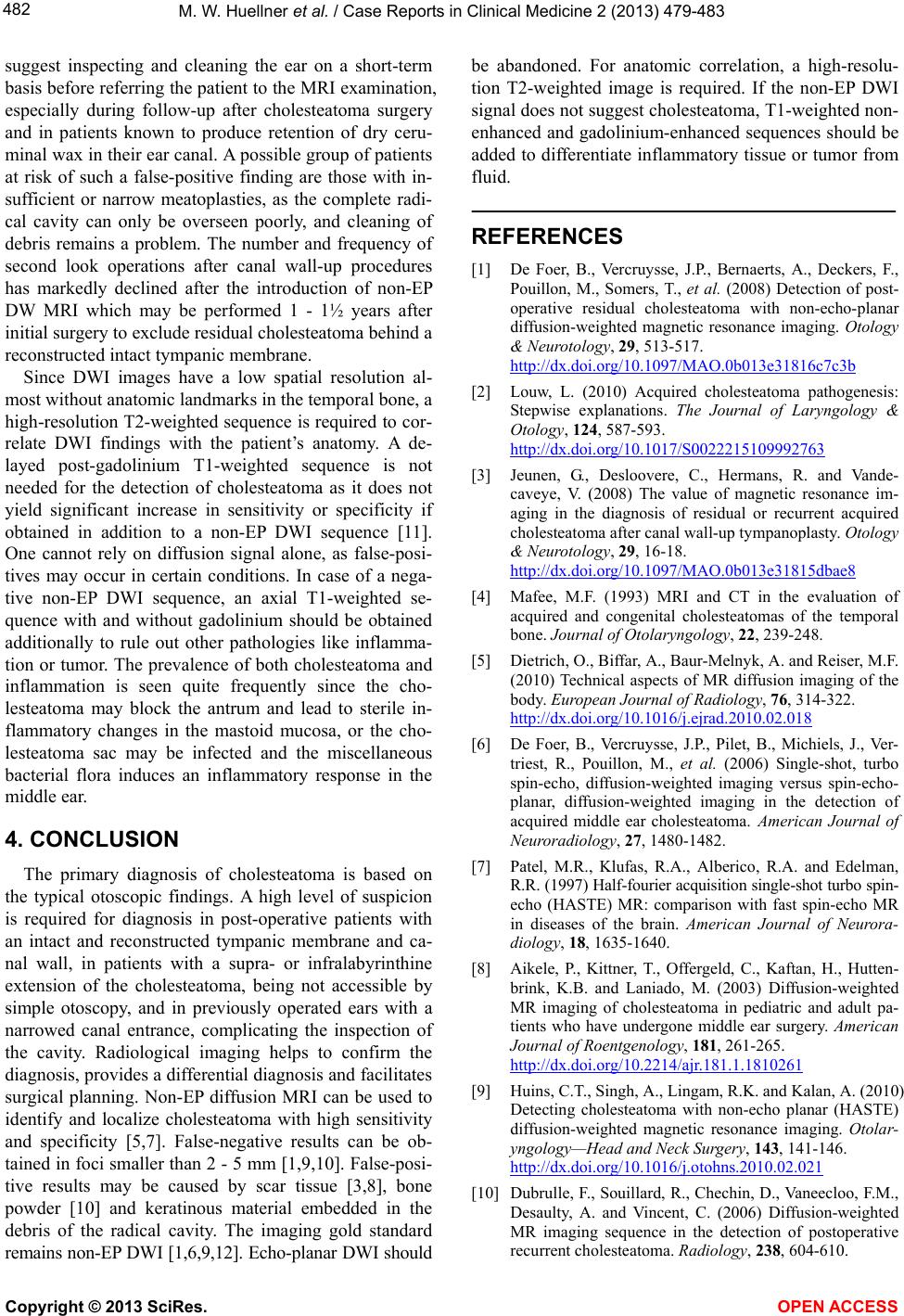
M. W. Huellner et al. / Case Reports in Clinical Medicine 2 (2013) 479-483
482
suggest inspecting and cleaning the ear on a short-term
basis before referring the patient to the MRI examination,
especially during follow-up after cholesteatoma surgery
and in patients known to produce retention of dry ceru-
minal wax in their ear canal. A possible group of patients
at risk of such a false-positive finding are those with in-
sufficient or narrow meatoplasties, as the complete radi-
cal cavity can only be overseen poorly, and cleaning of
debris remains a problem. The number and frequency of
second look operations after canal wall-up procedures
has markedly declined after the introduction of non-EP
DW MRI which may be performed 1 - 1½ years after
initial surgery to exclude residual cholesteatoma behind a
reconstructed intact tympanic membrane.
Since DWI images have a low spatial resolution al-
most without anatomic landmarks in the temporal bone, a
high-reso lution T2-weighted sequence is requir ed to cor-
relate DWI findings with the patient’s anatomy. A de-
layed post-gadolinium T1-weighted sequence is not
needed for the detection of cholesteatoma as it does not
yield significant increase in sensitivity or specificity if
obtained in addition to a non-EP DWI sequence [11].
One cannot rely on diffusion signal alone, as false-posi-
tives may occur in certain conditions. In case of a nega-
tive non-EP DWI sequence, an axial T1-weighted se-
quence with and without gadolinium should be obtained
additionally to rule out other pathologies like inflamma-
tion or tumor. The prevalence of both cholesteatoma and
inflammation is seen quite frequently since the cho-
lesteatoma may block the antrum and lead to sterile in-
flammatory changes in the mastoid mucosa, or the cho-
lesteatoma sac may be infected and the miscellaneous
bacterial flora induces an inflammatory response in the
middle ear.
4. CONCLUSION
The primary diagnosis of cholesteatoma is based on
the typical otoscopic findings. A high level of suspicion
is required for diagnosis in post-operative patients with
an intact and reconstructed tympanic membrane and ca-
nal wall, in patients with a supra- or infralabyrinthine
extension of the cholesteatoma, being not accessible by
simple otoscopy, and in previously operated ears with a
narrowed canal entrance, complicating the inspection of
the cavity. Radiological imaging helps to confirm the
diagnosis, provides a differential diagnosis and facilitates
surgical planning. Non-EP diffusion MRI can be used to
identify and localize cholesteatoma with high sensitivity
and specificity [5,7]. False-negative results can be ob-
tained in foci smaller than 2 - 5 mm [1,9,1 0]. False-posi-
tive results may be caused by scar tissue [3,8], bone
powder [10] and keratinous material embedded in the
debris of the radical cavity. The imaging gold standard
remains non-EP DWI [1,6,9,12]. Echo-planar DWI should
be abandoned. For anatomic correlation, a high-resolu-
tion T2-weighted image is required. If the non-EP DWI
signal does not suggest cholesteato ma, T1-weighted non-
enhanced and gadolinium-enhanced sequences should be
added to differentiate inflammatory tissue or tumor from
fluid.
REFERENCES
[1] De Foer, B., Vercruysse, J.P., Bernaerts, A., Deckers, F.,
Pouillon, M., Somers, T., et al. (2008) Detection of post-
operative residual cholesteatoma with non-echo-planar
diffusion-weighted magnetic resonance imaging. Otology
& Neurotology, 29, 513-517.
http://dx.doi.org/10.1097/MAO.0b013e31816c7c3b
[2] Louw, L. (2010) Acquired cholesteatoma pathogenesis:
Stepwise explanations. The Journal of Laryngology &
Otology, 124, 587-593.
http://dx.doi.org/10.1017/S0022215109992763
[3] Jeunen, G., Desloovere, C., Hermans, R. and Vande-
caveye, V. (2008) The value of magnetic resonance im-
aging in the diagnosis of residual or recurrent acquired
cholesteatoma after canal wall-up tympanoplasty. Otology
& Neurotology, 29, 16-18.
http://dx.doi.org/10.1097/MAO.0b013e31815dbae8
[4] Mafee, M.F. (1993) MRI and CT in the evaluation of
acquired and congenital cholesteatomas of the temporal
bone. Journal of Otolaryngology, 22, 239-248.
[5] Dietrich, O., Biffar, A., Baur-Melnyk, A. and Reiser, M.F.
(2010) Technical aspects of MR diffusion imaging of the
body. European Journal of Radiology, 76, 314-322.
http://dx.doi.org/10.1016/j.ejrad.2010.02.018
[6] De Foer, B., Vercruysse, J.P., Pilet, B., Michiels, J., Ver-
triest, R., Pouillon, M., et al. (2006) Single-shot, turbo
spin-echo, diffusion-weighted imaging versus spin-echo-
planar, diffusion-weighted imaging in the detection of
acquired middle ear cholesteatoma. American Journal of
Neuroradiology, 27, 1480-1482.
[7] Patel, M.R., Klufas, R.A., Alberico, R.A. and Edelman,
R.R. (1997) Half-fourier acquisition single -shot turbo spin-
echo (HASTE) MR: comparison with fast spin-echo MR
in diseases of the brain. American Journal of Neurora-
diology, 18, 1635-1640.
[8] Aikele, P., Kittner, T., Offergeld, C., Kaftan, H., Hutten-
brink, K.B. and Laniado, M. (2003) Diffusion-weighted
MR imaging of cholesteatoma in pediatric and adult pa-
tients who have undergone middle ear surgery. American
Journal of Roentgenology, 181, 261-265.
http://dx.doi.org/10.2214/ajr.181.1.1810261
[9] Huins, C.T., Singh, A., Lingam, R.K. and Kalan, A. (2010 )
Detecting cholesteatoma with non-echo planar (HASTE)
diffusion-weighted magnetic resonance imaging. Otolar-
yngology—Head and Neck Surgery, 143, 141-146.
http://dx.doi.org/10.1016/j.otohns.2010.02.021
[10] Dubrulle, F., Souillard, R., Chechin, D., Vaneecloo, F.M.,
Desaulty, A. and Vincent, C. (2006) Diffusion-weighted
MR imaging sequence in the detection of postoperative
recurrent cholesteatoma. Radiology, 238, 604-610.
Copyright © 2013 SciRes. OPEN ACCESS